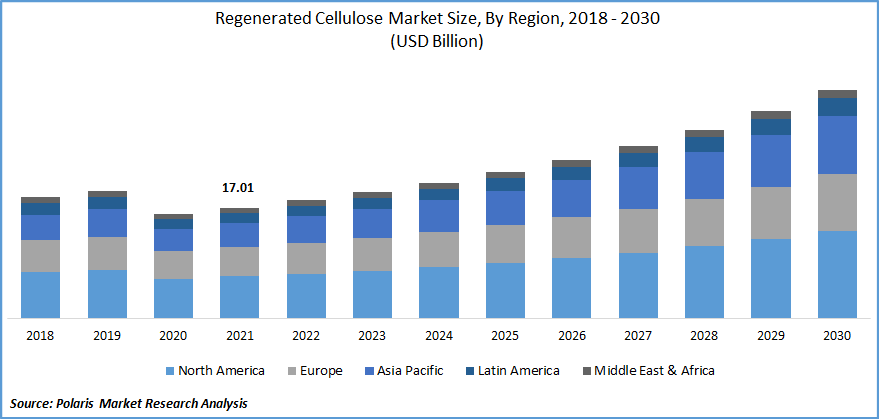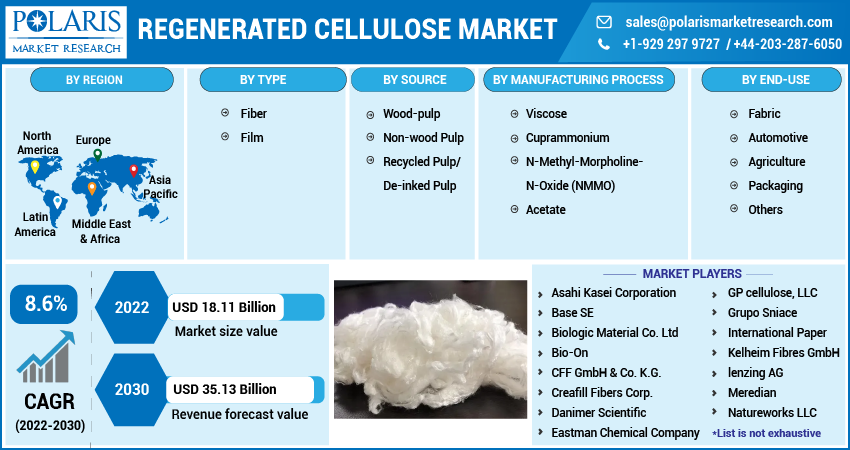
Regenerated Cellulose Market Share, Size, Trends, Industry Analysis Report, By Type; By Source (Wood-pulp, Non-wood Pulp, Recycled Pulp/De-linked Pulp); By Manufacturing Process; By End-Use; By Region; Segment Forecast, 2022 - 2030
- Published Date:Oct-2022
- Pages: 115
- Format: PDF
- Report ID: PM2667
- Base Year: 2021
- Historical Data: 2018-2020
Report Outlook
The global regenerated cellulose market was valued at USD 17.01 billion in 2021 and is expected to grow at a CAGR of 8.6% during the forecast period. The growing demand for the regenerated cellulose market is expected to be driven by the increasing income levels, rapid urbanization, and changing consumer preferences in emerging economies is supporting market growth.

Know more about this report: Request for sample pages
Regenerated cellulose is replacing petrochemical fibers owing to its low resiliency, high water absorption, strength, and easily dyeable, which has a wide application in end-use industries and boosts the market growth. Furthermore, regenerated cellulose material has a wide application in biomedicine, water treatment, agriculture, textiles, and electrical devices, which is expected to drive the market.
The COVID-19 pandemic had a negative impact on the growth of the regenerated cellulose market, owing to the halt in the production of raw materials that resulted in the disruption of the supply chain. In addition, labor crises and transportation delays also hampered several end-use industries, which led to a decline in the demand for the product. However, rising requirements for masks, disinfectant wipes, and paper towels were observed in the medical sector during covid, which supported the demand for the product.
The regenerated cellulose market has enormous demand in the automobile industry owing to the consumer shift from conventional to electric vehicles. Automotive manufacturers tend to develop lightweight cars; The cellulose nanofibers derived from wood pulp are their potential material as it requires low production cost and enhances the vehicle's performance. It reduces weight and is also completely eco-friendly, which will likely complement market growth over the forecast period.

For Specific Research Requirements, Request for a Customized Report
Industry Dynamics
Growth Drivers
The global regenerated cellulose is likely to be driven by the Asia Pacific owing to the increasing demand for textiles and apparel across China, India, and Japan. Also, the development in technology has enabled the production of filaments with a strong tensile performance which makes the fabric sustainable and breathable, which is likely to have a positive impact on market growth.
Furthermore, regenerated cellulose is environmentally friendly, biodegradable, similar to natural cellulose. Its production emits fewer greenhouse gases and other hazardous pollutants, which aids in regulating the earth’s climate and contributes toward the market’s growth.
Moreover, water treatment plants also have a massive demand for regenerated cellulose material owing to their low cost, better adsorption, and hydrophobicity. Cellulose aerogels are used to remove dyes, metals, and oils from polluted water, which boosts market growth.
Report Segmentation
The market is primarily segmented based on type, source, manufacturing process, end-use, and region.
|
By Type |
By Source |
By Manufacturing Process |
By End-Use |
By Region |
|
|
|
|
|
Know more about this report: Request for sample pages
Fiber Segment Accounted for the Largest Share in 2021
Based on type, fibers are anticipated to grow the fastest over the forecast period owing to increasing demand for environment-friendly products that enhance sustainability. The growing demand for fiber in the textile industry has resulted in the need for lyocell cellulose fiber due to its long tenacity.
In addition, regenerated cellulosic fibers are replacing synthetic fibers because of their properties, such as better absorbency, biodegradability, and normalizing body temperature; they are used to make undergarments and night clothes which is one of the significant factors contributing to the market growth.
Wood Pulp is Expected to Lead the Market over the Forecast Period
The demand for regenerated cellulose based on source is dominated by wood pulp owing to its reliability and sustainability. Regenerated cellulose made from wood pulp is frequently utilized in various applications, such as LCD screens, food casing, and binding agents in pharmaceutical companies.
In addition, the demand for wood pulp is rising food and beverage industry as it has been used in ice creams to make them creamier and in cheese to make them less sticky, which is expected to drive the growth of the market.
Viscose is Expected to Witness Faster Growth over the Forecast Period
The demand for viscose is expected to surge significantly over the forecast period owing to its various properties such as temperature resistance, good absorbency, lightweight, textured, glossy, and many more. It is soft, airy, breathable, and easily blends with other fibers that are helpful in the production of carpets, towels, innerwear, and fashionable dresses, which is likely to complement the market growth.
Moreover, viscose manufacturing technology is used in medical and industrial use in making surgical masks, caps, wipes, conveyer belts, tapes, and tire cords which is driving the market growth.
Fabric Industry is Expected to Account for the Largest Share in 2030
The fabric industry is expected to dominate the market over the forecast period owing to the rising consumer demand for comfortable, skin and environment-friendly fabric. In addition, increasing fashion trends and consumer shifts towards high-quality clothing are significant factors supporting the market growth. Moreover, the fabric industry provides a variety of products ranging from carpets to fashionable dresses, blankets, cushions, and many more, which is likely to have a positive impact on revenue growth over the forecast period.
Asia Pacific is Expected to Dominate and Witness Fastest Growth over the Forecast Period
The Asia Pacific is the largest region for the regenerated cellulose market. It is expected to witness faster growth over the forecast period owing to the largest market of woven fabrics and growing consumer awareness regarding sustainability and eco-friendly products across developing economies.
In addition, the automobile sector is also at its boom, focusing on manufacturing products that minimize emissions and are fuel efficient, which is expected to drive demand over the forecast period. Moreover, rapid urbanization and increasing disposable income are also factors contributing the market growth.
Competitive Insight
Some of the major players operating in the global market include Asahi Kasei Corporation, Base SE, Biologic Material Co. Ltd, Bio-On, CFF GmbH & Co. K.G., Creafill Fibers Corp., Danimer Scientific, Eastman Chemical Company, Fortress Global Enterprises Inc, Fulida Group Holdings Co, Ltd, Grasim Industries Limited, GP cellulose, LLC, Grupo Sniace, International Paper, Kelheim Fibres GmbH, lenzing AG, Meredian, Natureworks LLC, Plantic, Sateri, TianAn Biologic Materials Co. Ltd, Yield10 Bioscience, Inc.
Recent Developments
- In March 2022, Grasim Industries Limited had an agreement with Renewcell where both companies will be working to supply high-quality Liva Reviva textile fiber.
- In October 2021, Kelheim Fibres collaborated with Renewcell to develop superior-quality viscose fibers to establish a fashion loop where the fiber could be recycled and regenerated.
Regenerated Cellulose Market Report Scope
|
Report Attributes |
Details |
|
Market size value in 2022 |
USD 18.11 billion |
|
Revenue forecast in 2030 |
USD 35.13 billion |
|
CAGR |
8.6% from 2022 - 2030 |
|
Base year |
2021 |
|
Historical data |
2018 - 2020 |
|
Forecast period |
2022 - 2030 |
|
Quantitative units |
Revenue in USD billion and CAGR from 2022 to 2030 |
|
Segments Covered |
By Type, By Source, By Manufacturing Process, By End-Use, By Region |
|
Regional scope |
North America, Europe, Asia Pacific, Latin America, Middle East & Africa |
|
Key Companies |
Asahi Kasei Corporation, Base SE, Biologic Material Co. Ltd, Bio-On, CFF GmbH & Co. K.G., Creafill Fibers Corp., Danimer Scientific, Eastman Chemical Company, Fortress Global Enterprises Inc, Fulida Group Holdings Co, Ltd, Grasim Industries Limited, GP cellulose, LLC, Grupo Sniace, International Paper, Kelheim Fibres GmbH, lenzing AG, Meredian, Natureworks LLC, Plantic, Sateri, TianAn Biologic Materials Co. Ltd, and Yield10 Bioscience, Inc. |
